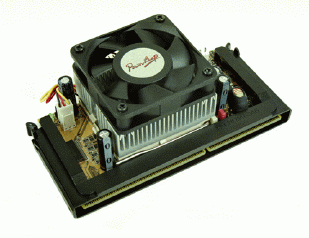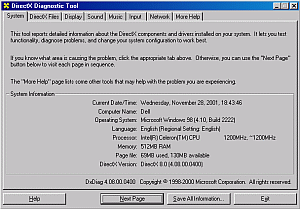| |
 |
PL-iP3/T installation photo page |
| |
| |
 |
Skip to the benchmark info |
The PowerLeap unit arrived in a plain white box, since the commercial packaging was not quite ready. Opening it, I was pleased to see that the unit appeared to be very sturdy and well made. A "Y-connector" type adapter allows the hookup to be made to an internal power connector, even if you don't have a spare. Just "daisy chain" it with an existing IDE device, and you're ready to go. The power connector provides the needed voltage to the adapter, as well as running the Intel cooling fan on the unit. No need to run a fan connector to the mobo, which is a nice convenience.
Installation couldn't have been easier in my R400. It was literally a matter of unplugging the fan lead and removing my Coppermine P3, and then seating the PowerLeap unit in the CPU slot and attaching the power lead. You can check out the installation sequence, complete with a series of photos HERE.
So, with the unit physically installed, I reattached the main power lead to my R400 and pushed the power button. The machine started normally, with nary a weird screen message, series of beeps, or any other sign of trouble. As is normal with the faster processors on the R-series machines, the BIOS (Dell's version A11, in this case) identified the CPU as a "500MHz Pentium Pro". This is purely a BIOS limitation and has nothing to do with the actual processor operation.
Click on individual images to enlarge
|
|
|
Once Windows 98SE had finished loading (nothing unusual here, either), I took a quick look at how Windows identified the CPU by running Microsoft's DirectX Diagnostic Tool. The processor was correctly identified as an Intel Celeron operating at 1200MHz, as shown in the screenshot at right.
H.Oda's popular WCPUID utility also correctly identifies the processor type and speed, but also includes a variety of other information on cache size and speed, multimedia support, and several other CPU characteristics. Make sure you use version 3.0f or higher, though--earlier versions do not identify the Tualatin Celeron processor correctly.
Next, I proceeded to run a number of routine tasks and applications, including web browsing, e-mail, word processing and a couple of games, and all was completely normal. The PL-iP3/T was looking good so far, but since good results had already been reported on other Dimension XPS-R machines, this wasn't unexpected. But would it run on the AOpen AX6BC motherboard, where I had no prior "success stories" from which to take encouragement?
Yep, just dandy, thank you! The installation and start-up on one of my homebuilt AX6BC's was similarly uneventful, and the same basic battery of tasks and applications showed no anomalies. So, after confirming the basic operability and stability of the PL-iP3/T rig on both systems, it was time to get serious and run some benchmarks!







